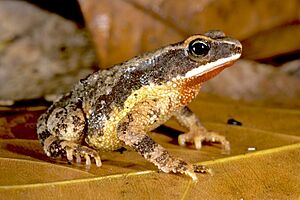Mertensophryne usambarae facts for kids
Quick facts for kids Mertensophryne usambarae |
|
|---|---|
 |
|
| Mertensophryne usambarae in Tanga, Tanzania | |
| Conservation status | |
| Scientific classification | |
| Synonyms | |
|
Stephopaedes usambarae Poynton and Clarke, 1999 |
The Usambara forest toad (scientific name: Mertensophryne usambarae) is a very special and rare type of toad. It lives only in a small area of northeastern Tanzania, near the Usambara Mountains. Sadly, this little toad is critically endangered, which means it's at a very high risk of disappearing forever. It belongs to the toad family Bufonidae.
Contents
About the Usambara Forest Toad
What Does It Look Like?
Usambara forest toads are quite small. Male toads grow up to about 3.5 centimeters (1.4 inches) long. Female toads are a bit bigger, reaching about 4.5 centimeters (1.8 inches).
Their backs are usually brown, sometimes with faint patterns. Their bellies can be plain or have some spots. They have flat glands behind their eyes called parotoid glands. These toads do not have visible eardrums. Their legs are short and covered with many small, cone-shaped bumps.
Where Does It Live?
This toad lives on the ground in lowland forests. It prefers areas that are not higher than 410 meters (about 1,345 feet) above sea level. It can even survive in forests that have been slightly disturbed, like those where some trees have been cut down.
Scientists don't know much about how these toads reproduce. However, some other toad species in the Mertensophryne group lay their eggs in puddles found among tree roots. It's possible the Usambara forest toad does this too. This toad is similar to another species, Mertensophryne micranotis, and they can sometimes be found living in the same places.
Why Is It Endangered?
The Usambara forest toad is only found in three specific locations that are close to each other. It seems to be quite rare. For example, in 2012, scientists searched for three days but only found two toads.
This species is in danger because its forest home is shrinking. People are clearing land for farming and building new homes. They are also cutting down trees for wood. Even though the places where these toads live are protected forest reserves (Kwamgumi, Segoma, and Mtai Forest Reserves), they are not always well-guarded.
Because of its very small living area and the threats to its home, the International Union for Conservation of Nature (IUCN) listed this toad as "Critically Endangered" in 2016. This means it needs urgent help to survive.


